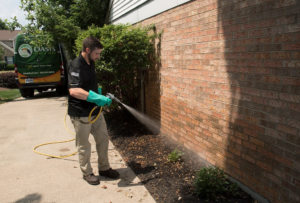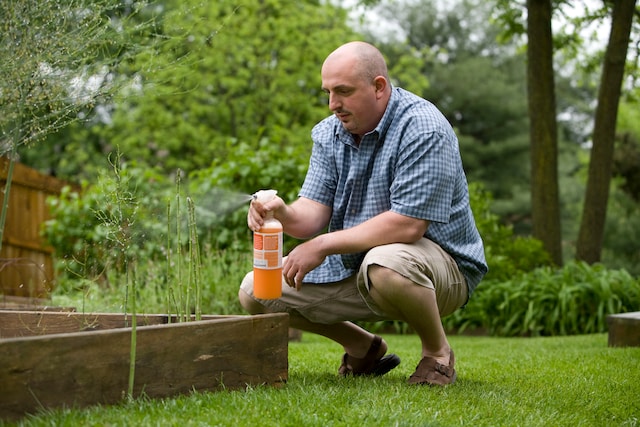Natural features such as mountains and lakes restrict the spread of many pests. Other natural factors, such as weather and available food and water, influence their populations.
Some pests – such as plum curculio, flea beetles, gypsy moths, and plant bugs in trees and shrubs – are persistent and require regular control. Others have boom and bust cycles, depending on seasonal conditions.

Identifying pests is the first step in integrated pest management. Accurate identification allows you to recognize what type of pest you have and to select appropriate management tactics that will control the pest without harming beneficial organisms, people or pets.
Most pests have different physical forms at different stages in their life cycle. Knowing which form they are in helps you to detect and identify them – for example, a weed seedling looks quite different from the mature plant. Knowing what stage a pest is in also helps you to determine whether it requires treatment. Identification also helps you avoid applying pesticides to the wrong type of insect, which can cause damage or injury and waste time and money.
Pests are often more than just a nuisance, and some can carry diseases and contaminate food or personal items. They also destroy gardens and crops.
The purpose of pest control is to reduce the number of pests to a level that is acceptable for you and your environment. Identifying pests, monitoring their numbers and removing any factors that favor them, can help prevent them from reaching unacceptable levels.
Many pest problems can be controlled without the need for chemical applications. Sanitation, properly storing foods and garbage, sealing cracks around the home, cleaning and reusing compost containers, and removing standing water from the yard are some examples of preventive strategies.
Some pests can only be prevented by being vigilant and looking for signs of them, such as their feces or discarded egg shells. Others require a change in their habitat, such as removing or adding mulch to the garden, maintaining clean compost bins and relocating bird feeders away from houses.
Some pests are persistent and need regular monitoring, such as cockroaches, mice, fleas and cluster flies. Other pests are sporadic or migratory and need only occasional controls, such as boxelder bugs, grasshoppers and mosquitoes. The best way to determine if pests need control is through “field scouting,” which means searching for and identifying pests regularly, usually daily or weekly depending on the type of pest.
Barriers and Exclusion
A physical barrier is often the best line of defense against pest invasions. Also known as pest exclusion, it involves sealing the gaps, routes and pathways that pests use to enter homes or commercial facilities. It can be done in conjunction with population reduction techniques or as a preventive measure to keep critters out for good.
It starts with an inspection, identifying the problem areas of entry. Then, the appropriate barriers can be installed. For example, a gap that allows rodents to squeeze through can be closed with weather stripping, metal screens or spray foam. For holes larger than a quarter of an inch, exclusion fill fabrics, stainless steel mesh or even sheet metal may be used. Other items, like door sweeps or parasitic nematodes, can help close the space under doors where rats and cockroaches commonly slip inside.
In addition to exclusion, minimizing things that attract pests is critical. Food scraps, crumbs and trash should be kept away from buildings. Yard debris, leaf piles and other clutter can serve as shelter for rodents and birds and should be cleared regularly. And, of course, all pet foods should be stored properly and not left out in the open where pests can easily find them.
For areas that can’t be sealed, such as vents and drainpipes, a simple copper mesh will keep pests out without allowing water to flow or air to get in. It’s easy to install and doesn’t stain. Our favorite product for this application is Stuf-It copper mesh, available from Solutions Pest & Lawn.
For large commercial facilities, pest exclusion methods can be especially effective when coupled with a comprehensive integrated pest management plan. This includes inspections and repairs to exterior walls, removing any harborage sites and implementing interior improvements that inhibit pest movement between spaces. This helps limit the need for costly chemical interventions and protects the reputation of a facility. New technologies, such as sealants and particle barriers designed specifically for the pest management industry, are also helping eliminate termites and cockroaches from structures with difficult-to-access crevices.
Bait Stations
Rodent bait stations contain poisons to control rodent pests. They offer the advantage of controlling rodents in places where traps cannot be placed because of a lack of shelter or access to food sources. These tamper-resistant containers are usually small boxes designed to hold solid or liquid rodenticides (poisons). They can be made at home from scrap materials, purchased prefabricated, or even attached to the pens of poultry houses or swine confinement buildings. Some manufacturers use locks, seals or concealed latches to make the bait station more tamperproof.
Bait stations also reduce the amount of environmental buildup and non-target pesticide residue, especially for liquid rodenticides. They can be a good alternative to other rodenticide treatments, which can leave residues that can be hazardous to pets and children.
While mice and rats may look cute in the pet store, they are a serious household problem that can produce numerous litters of offspring each year. They can gnaw through doors, walls and cabinets, contaminate food, and spread diseases. In addition, they gnaw through wires and other electrical components, potentially creating dangerous electrical fires.
It can take a few days for rodents to discover and begin using a new bait station, depending on the stability of their environment. It is important to locate the bait station where rodents are most active, such as near rodent burrows, along walls or travel routes. If possible, the station should be located directly next to an active trail. It may be necessary to place several bait stations in areas where rodents are abundant.
Unlike traps, there are no dead rodents to dispose of in a bait station. Mice and rats enter the container, eat the bait, and then leave to return to their nests or feed locations. They die a few days later, typically in their nests or feeding areas, often from internal bleeding caused by anticoagulants.
Although rodents can gnaw through plastic, most manufacturers of bait stations construct them out of durable materials that are suitable for outdoor placement. These include sturdy plastics and metal. Regardless of the material, it should be weather-resistant and constructed to prevent the tampering of children or other non-target species.
Traps
Insect traps are a staple of pest control programs. Sticky traps capture spiders, ants, and other insects that try to sneak into your home. These traps can be useful in solving limited pest problems such as a single wolf spider or a few crickets in a room, and they provide valuable information to both the homeowner and the pest control professional. Traps can also help reduce the need for treatments if a targeted placement and specialized pheromone attractants are used to make traps more effective against specific pest species and less likely to catch other organisms.
Monitoring traps, such as yellow sticky traps for cockroaches or pheromone traps that target Indian meal moths and cigarette beetles in storage and food warehouses, are used to provide information about the extent of pest infestations. The information gathered from these traps can be used to guide treatment strategies, such as flushing cockroaches or spraying a chemical to kill them, depending on the contributing conditions.
When pest populations reach high numbers, the trapping program may also include releasing natural enemies such as beneficial nematodes to reduce their numbers. Traps can be set at different times during a pest’s life cycle to better time the application of these biological controls.
Interpreting sticky trap data is challenging and takes experience, knowledge of the pest species being targeted, and careful attention to contributing conditions. The type and density of crop foliage, temperature, air movement, and pesticide applications all influence the number of insects trapped on traps.
It is important to regularly check traps and dispose of the insects as necessary, especially after a treatment. Traps should be moved to new locations and cleaned as needed to reduce the risk of them catching other pests or animals. Checking traps can also help prevent accidental contamination by removing old, contaminated traps from their original location before they can contaminate other areas. If you are using a glue trap, make sure it is non-toxic and safe to use in your environment, and be careful when setting it out near plants or water sources.




